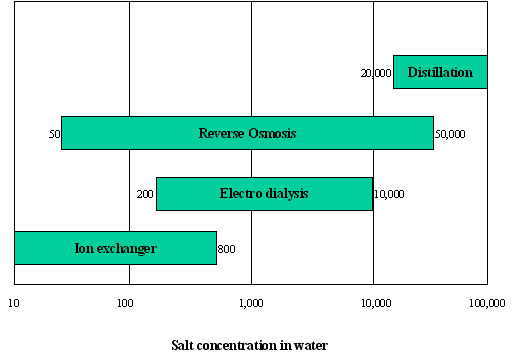Desalination with Reverse Osmosis modules
Membrane technology
Osmosis
is a natural phenomenon, without which life would be made impossible. Osmotic
processes enable plants to absorb nutrients from the ground. Our kidneys purify
the blood in our bodies by means of osmosis.
Although osmosis has been discovered
and studied as early as 1850, it has taken us until 1960 to be able to apply the
process for water desalination.
Membrane filtration has been approached
as a futuristic, expensive and complex process for a very long time. However,
in the past fifteen years this process has developed to a mature and reliable
technique, which is very usable for (drinking) water purification.
When
we are dealing with a system, consisting of two fluids that are separated by a
semi permeable membrane (permeable, just not for salts) and we add salt on one
side of the system, pure water will start flowing through the membrane. This flow
will continue until the pressure is equal on both sides of the membrane. Afterwards
the water level will be higher where the salt was added. The difference in water
level, caused by the addition of a specific amount of salt, is called osmotic
pressure. The osmotic pressure of seawater is around 26 bar.
We can explain
the term reverse osmosis as follows:
To desalinate water, we must create a
flow through a membrane, causing the water to leave the salty side of the membrane,
flowing into the unsalted side. To achieve this, pressure must be created upon
the water column on the salt side of the membrane; firstly, to remove the natural
osmotic pressure and secondly, to create extra pressure on the water column, in
order to push the water through the membrane. For the desalination of seawater,
the pressure must be about 50-60 bars (725 - 870 psi).
There are several
different techniques that can be applied for water desalination. Examples are
reverse osmosis, electro dialysis, distillation and ion exchange (see image).
Reverse osmosis is the most economic process for the desalination of brackish
water and seawater. When we compare this process to the traditional thermic process
of distillation, the capital investments and the energy use are much lower.

Reverse Osmosis modules
There are four different types of reverse osmosis modules, which are used for reverse osmosis processes, mainly desalination processes. These are the tubular, plate & frame, spiral, and hollow fiber modules.
The system costs for the treatment of mineral water are
the same for spiral modules and hollow fiber modules. Pre-treatment costs for
the purification of surface water are higher when hollow fiber membranes are used.
These membranes require a more specific pre-treatment, because they are more susceptible
to fouling.
The use of tubular modules and plate & frame modules may be
more expensive than that of hollow fiber modules or spiral modules. The costs
of the use of tubular modules and plate & frame modules are approximately
equal.
The required system space for the modules is very high when hollow
fiber modules or spiral modules are used. Tubular modules take up much less space.
It has been said that for reverse osmosis systems for the desalination of
seawater, spiral membranes are used most often.
Reverse Osmosis desalination
installation (seawater)
System design
Factors that influence prestations
If you have any questions considering this or other filtration systems, feel free to contact us



